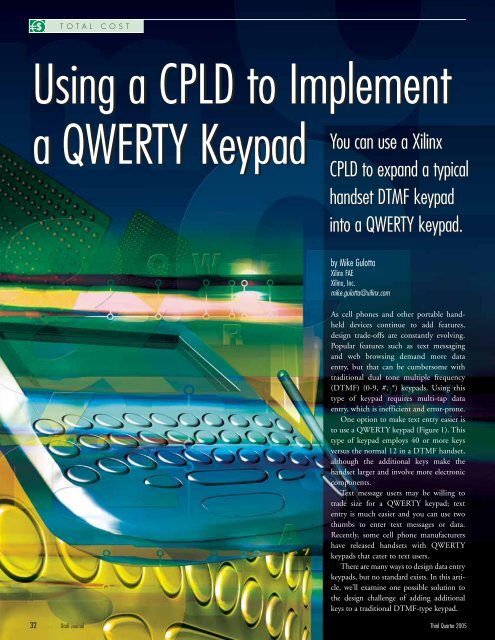Design Challenges: Avoiding the Pitfalls, winning the game - Xilinx
Design Challenges: Avoiding the Pitfalls, winning the game - Xilinx
Design Challenges: Avoiding the Pitfalls, winning the game - Xilinx
You also want an ePaper? Increase the reach of your titles
YUMPU automatically turns print PDFs into web optimized ePapers that Google loves.
$<br />
TOTAL COST<br />
Using a CPLD to Implement<br />
a QWERTY Keypad<br />
You can use a <strong>Xilinx</strong><br />
CPLD to expand a typical<br />
handset DTMF keypad<br />
into a QWERTY keypad.<br />
by Mike Gulotta<br />
<strong>Xilinx</strong> FAE<br />
<strong>Xilinx</strong>, Inc.<br />
mike.gulotta@xilinx.com<br />
As cell phones and o<strong>the</strong>r portable handheld<br />
devices continue to add features,<br />
design trade-offs are constantly evolving.<br />
Popular features such as text messaging<br />
and web browsing demand more data<br />
entry, but that can be cumbersome with<br />
traditional dual tone multiple frequency<br />
(DTMF) (0-9, #, *) keypads. Using this<br />
type of keypad requires multi-tap data<br />
entry, which is inefficient and error-prone.<br />
One option to make text entry easier is<br />
to use a QWERTY keypad (Figure 1). This<br />
type of keypad employs 40 or more keys<br />
versus <strong>the</strong> normal 12 in a DTMF handset,<br />
although <strong>the</strong> additional keys make <strong>the</strong><br />
handset larger and involve more electronic<br />
components.<br />
Text message users may be willing to<br />
trade size for a QWERTY keypad; text<br />
entry is much easier and you can use two<br />
thumbs to enter text messages or data.<br />
Recently, some cell phone manufacturers<br />
have released handsets with QWERTY<br />
keypads that cater to text users.<br />
There are many ways to design data entry<br />
keypads, but no standard exists. In this article,<br />
we’ll examine one possible solution to<br />
<strong>the</strong> design challenge of adding additional<br />
keys to a traditional DTMF-type keypad.<br />
32 Xcell Journal Third Quarter 2005

















